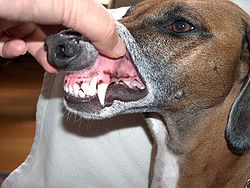Canine Tooth Details
- Canine teeth are also known as cuspids, dog teeth, eye teeth, vampire teeth, or vampire fangs.
- They are relatively long and pointed.
- Canines are used for firmly holding and tearing food, as well as occasionally as weapons.
- They are often the largest teeth in a mammal's mouth.
- Most species have four canines, two in the upper jaw and two in the lower.
Canine Tooth Eruption
- Upper canines (eye teeth) erupt between the ages of eleven and twelve years, while lower canines erupt between nine and ten years.
- Deciduous canines (baby teeth) typically erupt between sixteen and twenty-two months and shed between ten and twelve years.
- The upper canines are larger and longer than the lower canines.
- Upper canines usually have a distinct basal ridge.
- Lower canines usually erupt slightly earlier than upper canines.
Developmental Defects
- Transposition, the positional interchange of two adjacent teeth, is a common developmental defect in canines.
- The upper canine is frequently transposed with the first premolar, while the lower canine is transposed with the lateral incisor.
- Occasionally, canines can be congenitally missing.
Maxillary Canine Morphology
- Maxillary canines are approximately one millimeter narrower than the central incisor from a facial aspect.
- They resemble the adjacent lateral incisors on their mesial aspects and anticipate the first premolars on their distal aspects.
- Maxillary canines are slightly darker and more yellow in color compared to other anterior teeth.
- They have well-developed mesial and distal marginal ridges and a prominent lingual ridge.
- The root of the maxillary canines is the longest root of any tooth and conical in shape.
Mandibular Canine Morphology
- Mandibular canines are placed closer to the middle line than the upper canines.
- They are notably narrower mesiodistally than the maxillary canines.
- The root of the mandibular canines may be just as long as the maxillary canines and can be bifurcated.
- The mandibular canines have a nearly straight outline compared to the slightly bowed maxillary canines.
- Lingually, the surface of the mandibular canines is smoother and the cingulum is less developed compared to the maxillary canines.
Functions of Canine Teeth
- Canine teeth are used for biting and tearing food.
- They play a crucial role in the process of mastication.
- Canines help in maintaining the shape and alignment of the dental arch.
- These teeth aid in speech production by controlling airflow.
- Canine teeth contribute to facial aesthetics by providing support to the lips and cheeks.
Dental Development and Agenesis
- Agenesis of maxillary permanent canines is a rare condition.
- Bilateral agenesis of maxillary canines has been reported in the literature.
- The prevalence of agenesis of maxillary canines varies among different populations.
- Dental agenesis can have genetic and environmental causes.
- A multidisciplinary approach is necessary for the management of agenesis cases.
Sexual Dimorphism and Canine Size
- Canine sexual dimorphism in Ardipithecus ramidus resembles that of humans.
- The size of canines can be an indicator of sexual selection.
- Wide faces and large canines have been associated with aggressive behavior in primates.
- Canine size can influence attractiveness in primate species.
- Canine size may have played a role in the evolution of human facial features.
Evolutionary Significance of Canine Teeth
- Canine teeth have been present in mammalian ancestors for millions of years.
- The shape and size of canines have evolved in response to dietary changes.
- Canine teeth have been used for intraspecific competition and display.
- Canines can be used as weapons for defense and predation.
- The presence of canines in different species reflects their adaptive significance.
Dental Anatomy and Histology
- Canine teeth have a single root and a pointed crown.
- The enamel of canine teeth is thicker compared to other teeth.
- The pulp chamber of canines is relatively large.
- Canine teeth have a well-developed periodontal ligament.
- Histological analysis reveals unique features of canine tooth structure.
In mammalian oral anatomy, the canine teeth, also called cuspids, dog teeth, eye teeth, vampire teeth, or vampire fangs, are the relatively long, pointed teeth. In the context of the upper jaw, they are also known as fangs. They can appear more flattened however, causing them to resemble incisors and leading them to be called incisiform. They developed and are used primarily for firmly holding food in order to tear it apart, and occasionally as weapons. They are often the largest teeth in a mammal's mouth. Individuals of most species that develop them normally have four, two in the upper jaw and two in the lower, separated within each jaw by incisors; humans and dogs are examples. In most species, canines are the anterior-most teeth in the maxillary bone. The four canines in humans are the two upper maxillary canines and the two lower mandibular canines. They are specially prominent in dogs (Canidae), hence the name.
| Canine tooth | |
|---|---|
 | |
| Details | |
| Identifiers | |
| Latin | dentes canini |
| MeSH | D003481 |
| TA98 | A05.1.03.005 |
| TA2 | 907 |
| FMA | 55636 |
| Anatomical terminology | |
So called because canine teeth are prominent in dogs.
canine tooth (plural canine teeth)